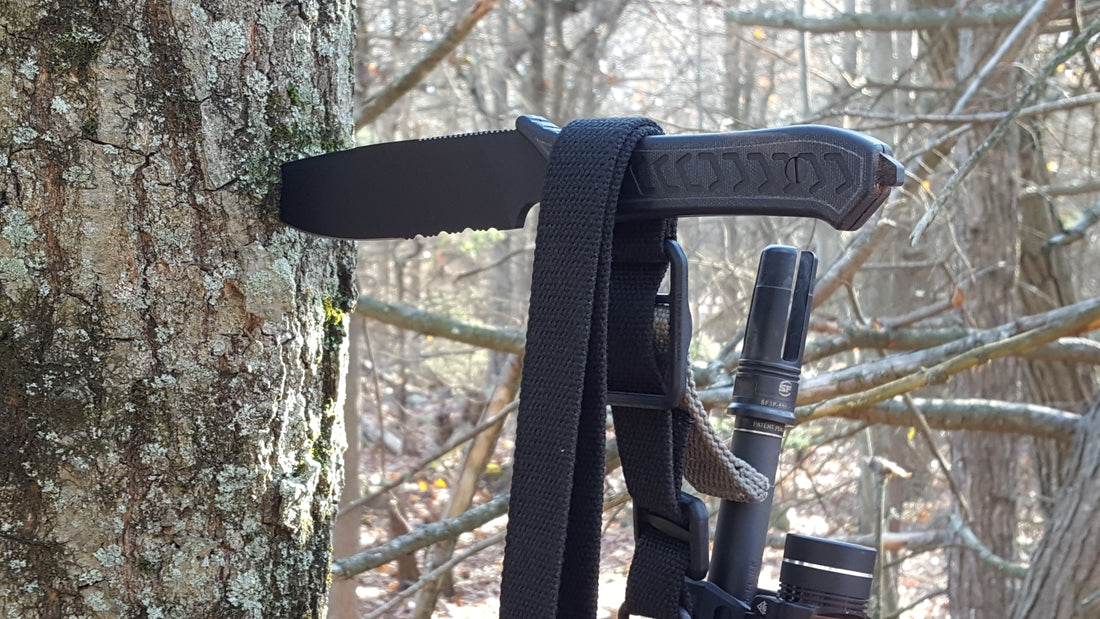By: Kevin Estela, Owner/Head Instructor of Estela WIlderness Education
“Knives need sheaths, pistols need holsters and rifles need slings.” I don’t remember where I heard that expression but it has always rung true with me. Often, we focus too much on the tool and not enough on how we carry it. Unless you walk around with your knife, pistol, or rifle in your hand(s), you need to put them somewhere when they aren’t in use. That’s the purpose of the sheath, holster or sling. Let’s face it, it’s easy to get wrapped up in the latest and greatest gear with millions of dollars of clever marketing making it seem like a must-have item. I’ll admit, I’ve been duped into buying something I didn’t need before. We tend to seek out luxuries before the most basic accessories are acquired. In this world of “nice to have” items, I like to focus on the “must have” items and examine the reasons “why?” When the little details are examined with a fine-tooth comb, the mission critical understanding is brought to light. Since we only have one set of hands, we only have so much control over our rifle. When we need to reach for that MISSION knife, where does our rifle go? When we need our hands to climb, do we leave our rifle behind? When one hand gets injured, do we consider a rifle useless? With the right sling, we find answers to all these questions.
Climbing
When climbing a ladder, you should maintain at least...AT LEAST...2 points of contact with the rungs but better yet, you should have three points if you can. I don’t know when you’ll need to climb a ladder, scale a rock face or climb some other structure but I know for damn sure it will be easier with both of your hands free. If you goof up on a 6 foot ladder, you probably won’t hurt yourself too badly but the same can’t be said for a ladder high on a trail, attached to a building or against a wall. A good sling lets you wear your rifle across the back, muzzle up or muzzle down, and cinched against your body. This frees up your hands to do the work they need to. Climbing a ladder is much easier than climbing rock faces and you never know what kind of obstacles may be in your path.
Trekking/Hiking
In Alaska in 2016, I spent the better part of 3 weeks on the North Slope of the Brooks Range. I carried a pistol in a chest pack and my rifle over my shoulder. Even when I wasn’t technically hunting, my rifle was carried because it was grizzly territory and I wasn’t going to leave it in camp. Since my buddy/guide Mark and I spent much of the trip fishing for our food, the scent of fresh fish was always with us. Therefore, our rifles were always with us. When worn with a backpack, a rifle sling finds a “pocket” between the neck and the shoulder pad and sort of “locks” in place. A basic rifle sling can help you shoulder your firearm muzzle up or muzzle down while hiking or trekking. With practice, it can be brought up on target quickly from a shoulder-carried position. Granted, if you want to ensure you’ll be ready to take a shot when you need to, you should have your rifle in your hand and off your shoulder.
Stability for Accuracy
The more points of contact on the rifle, the more stable the shot. Going prone is inherently the most stable and shooting from the standing position is on the other end of the stability spectrum. In between these two are seated and variations of kneeling shots with one or two knees on the ground. Further variations will specify elbows in, on, or around the knee(s). A quality sling greatly improves the accuracy of each shot by cinching against the torso and arms. With an arm fished through the sling and with the sling wrapped around the upper arm, a sling becomes advantageous in the fight against movement. When shooting from behind cover, a sling can be held like a forward grip on a rifle against the corner of the structure. A good sling should be quickly adjustable and firmly attached where it won’t interfere with normal manipulations of the rifle.
One-Hand Manipulation
Speaking of manipulation, a quality sling can assist in single-hand manipulations of the rifle should the other hand get injured. Assuming the support hand is injured in a fall or in a fight, a shooter can take a knee behind cover, loop the rifle sling around the knee, posture up slightly and in a way to stretch the sling taught, and use the tension on the rifle to hold it in place while the magazine and the bolt are worked. Once the immediate action is addressed, the sling can be used to support the front end of the rifle while the firing hand works the trigger. Just because you are without the use of one hand, doesn’t mean you are out of the fight.
Weapon Transition
If you are carrying a rifle, you probably have a handgun or at least a blade (maybe a MISSION Knife) on your person too. A good sling, like the Vicker’s Sling from Blue Force Gear used in this blog post,will help you transition from one to another and keep your rifle out of the way until you are ready to access it again. From rifle to pistol or rifle to blade, the rifle is moved out of the way with the support hand as the firing hand begins to access the pistol or blade. When done simultaneously, the transition is very quick and seamless. Accuracy is only important factor. The faster you can transition from one weapon to the next is another. When you are ready to transition back to your rifle, you know it is by your side attached to the sling around your torso.
From hunter to armed professional it’s true, every rifle needs a sling. Slings may not have as much cool factor as the latest weaponlight or as much fantasy effect of an IR or green laser but they have plenty of value and purpose. Just like all the other accessories on the market, the number of slings to choose from can be overwhelming. Ask good questions before you buy. What is the sling strap made out of? What material is the hardware? Plastic? How much can the sling be adjusted? Can it be adjusted with one hand or does it require two and an instruction manual. When it comes time to decide, think about what you want it to accomplish for you and purchase based on need rather than want.








